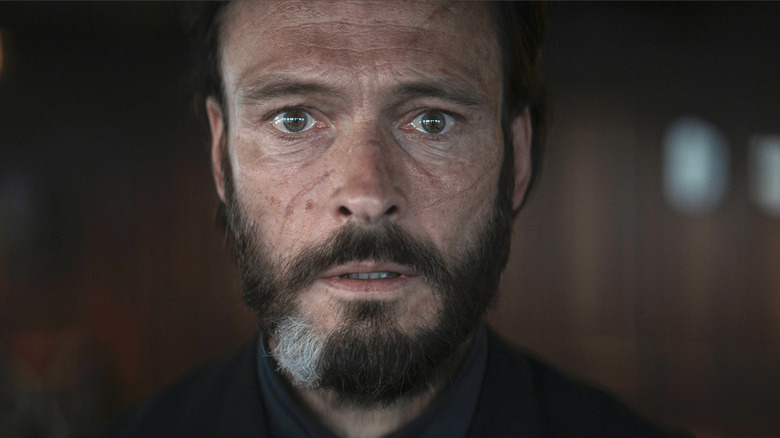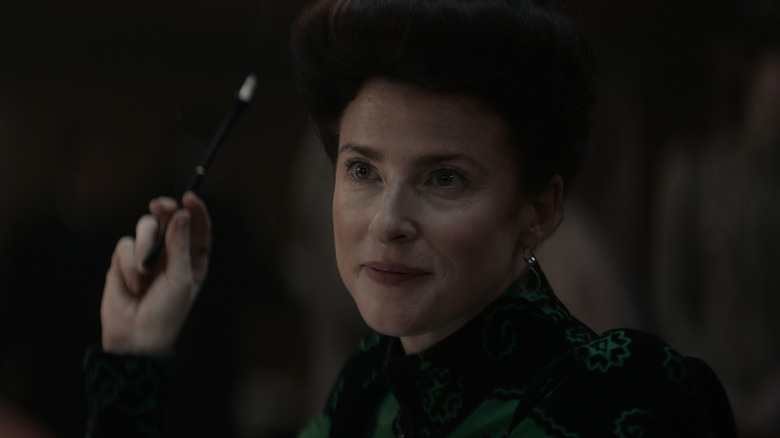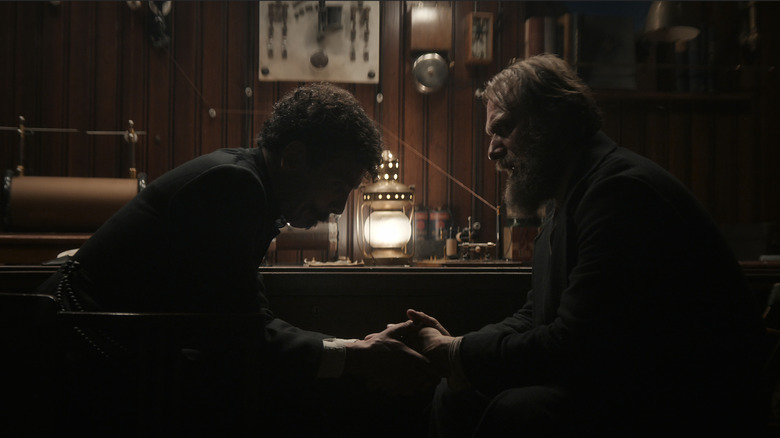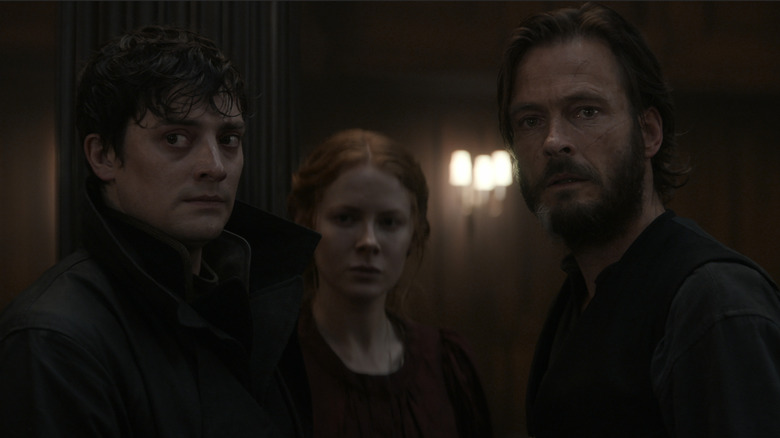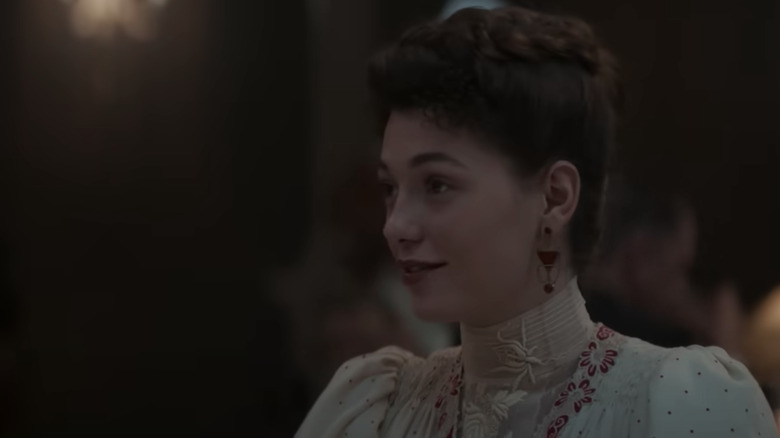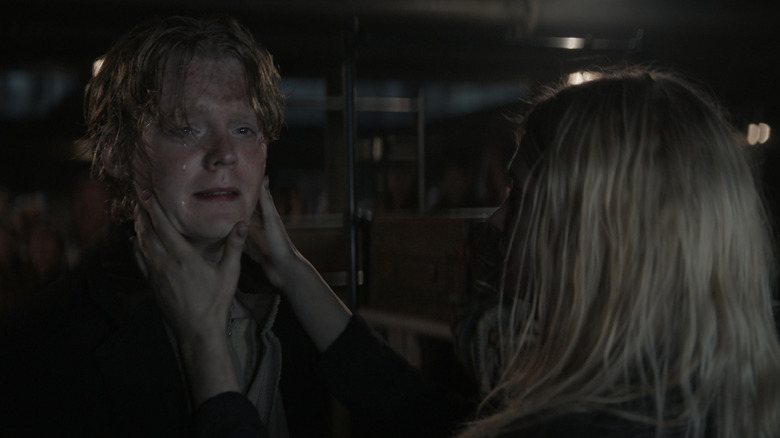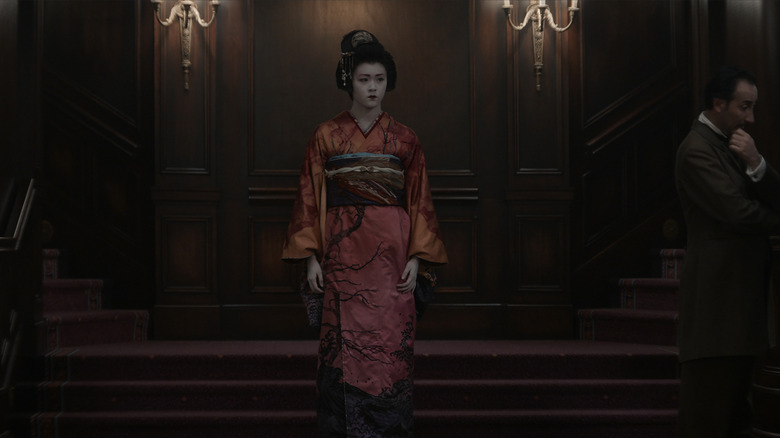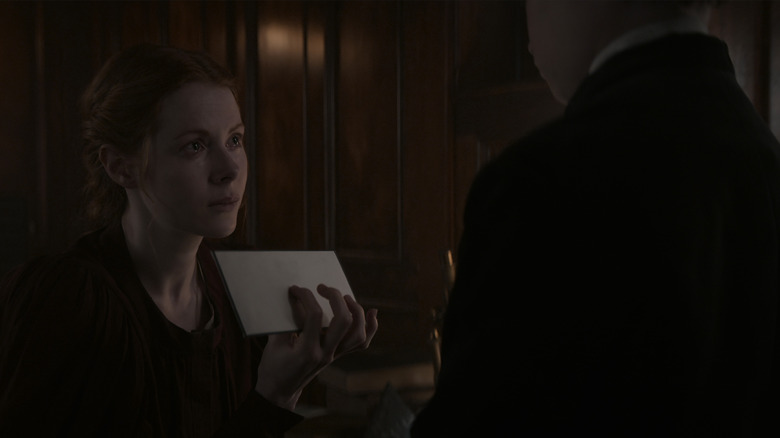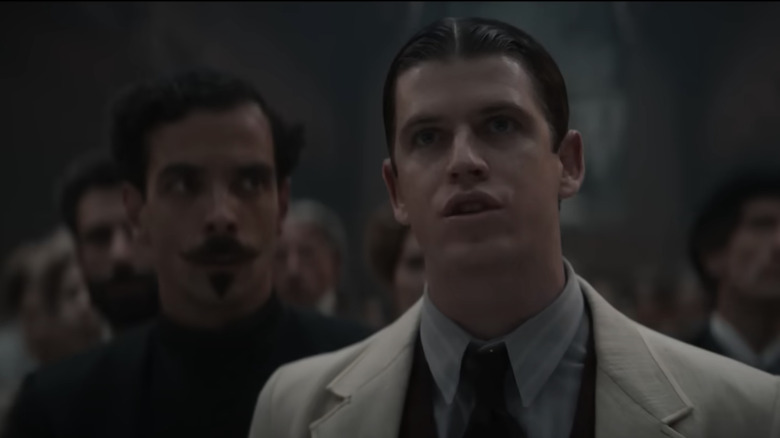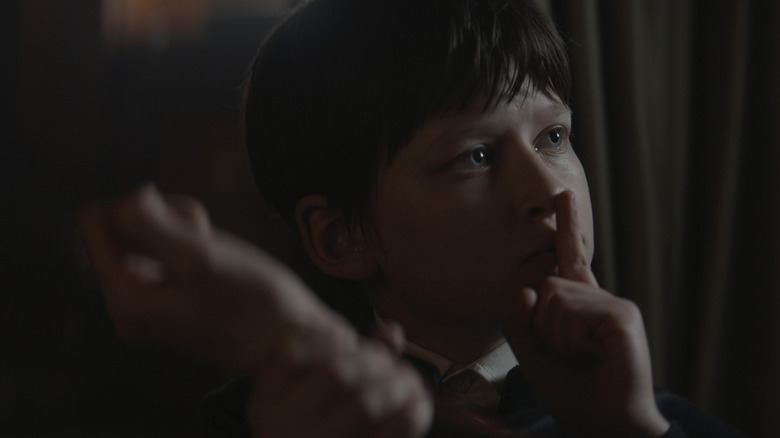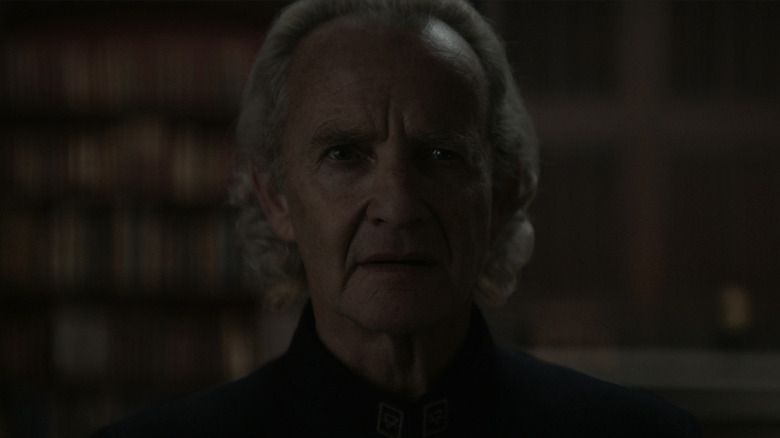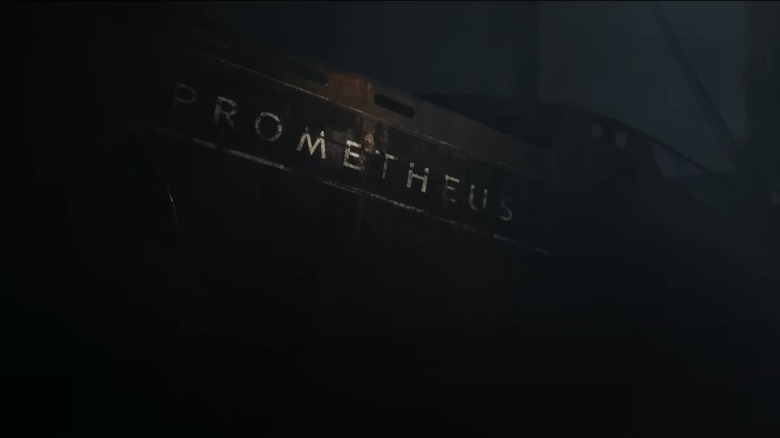Small Details You Missed In Netflix's 1899
For fans of the international thriller series "Dark," there's a new science-fiction mystery show to watch. Premiering on Netflix on November 17th, "1899" is the brainchild of filmmakers Jantje Friese and Baran bo Odar. Best described as a gothic mashup of "Lost," "Westworld," and 1972's "The Poseidon Adventure" (with a healthy dose of "The Matrix"), "1899" follows a group of travelers on a steamship heading from England to America. However, nothing on the Kerberos is what it seems, leaving all on board questioning their reality.
Just as "Dark" was a twisty, puzzling show with an ensemble cast, "1899" is unsettling and mysterious and features a talented cast from all over the world. No fewer than seven different languages can be heard in each episode. Reading subtitles keeps viewers glued to their screens rather than scrolling on their phones. In fact, the use of so many different languages is one of the best aspects of their series. Not only does the inclusion of its diverse cast mean that the series feels more realistic, but it also adds a clever layer of confusion as the ship becomes a veritable "Tower of Babel." According to bo Odar and Friese, this gives the actors a unique opportunity to just "react" since they truly didn't understand each other.
So far, "1899" has received mostly positive reviews, though there's no official word on whether there will be a second season. However, bo Odar and Friese told The Hollywood Reporter that they've planned for three "complicated" seasons (naturally). So, for those fans who were too busy trying to figure out just what exactly was happening on board the Kerberos, here are a few small details you might have missed.
Spoilers ahead.
The recurrence of the triangle
Clearly, "1899" has got a thing for triangles. There's the giant black pyramid looming in the background, as well as the miniature one Elliot carries around (and which has the power of resurrection and teleportation, it seems). Yet, even with all the triangles sketched onto trap doors and acting as a sort of new-age Morse code, only the sharpest-eyed viewers would have been able to catch all the little triangles hidden in the scenes.
At the beginning of the series, Mrs. Wilson (Rosalie Craig) waltzes into the dining room in her gorgeous emerald-green gown, dripping confidence and disdain for her fellow travelers. That distinctive dress has several small triangles hidden in the pattern. Watch for them closely as she sits next to Maura (Emily Beecham).
Similarly, Clemence (French actress Mathilde Ollivier) wears a beautiful pair of red enamel earrings shaped like an upside-down triangle, mirroring the look of Maura's necklace. In case that's not enough, check out the plush carpets in the first-class hallways, all of which have a clever triangle pattern that's most noticeable when Daniel reaches down and deposits Alfred the bug onto the floor. Oh, and of course, we can't forget the ornate brass number plates on each doorway in first class, at the bottom of which is a small triangle.
There are multiple repeating numbers
For those of us without a head for figures, the constantly repeated numbers and the obvious numerology of "1899" might have become a bit lost with all the mutinous action happening. But despite their subtlety, the numbers hidden throughout the Kerberos are a playful and important part of the series. According to bo Odar and Friese, even the name of the series is a mathematical puzzle. "Of course, the number is also very magical: 1899. You can do a lot of things with it. One plus eight is nine. So you have 999. If you turn that upside down, it's 666, the number of the beast," bo Odar told The Hollywood Reporter.
That's not all, though; 1011 is Maura's room number on the Kerberos, as well as the number of the torturous memory room in the mental hospital. 1011 is also considered an 'angel number,' which in numerology means a meaningful sequence of repeating numbers. And as we discover, there were over 1,423 passengers and 550 crew on the Prometheus ship, a number we see again when Maura wakes up and discovers that there are similarly 1,423 passengers and 550 crew on the spaceship.
A Twitter meme is a running gag
Of all the places to find a trite inspirational quote — usually emblazoned on cheap mugs in a bad font — the Prometheus in "1899" wasn't one of them. Yet, a popular Twitter meme and Pinterest saying, "May your coffee hit you before reality does," appears in several episodes.
When Anker (Alexandre Willaume) and Ramiro (José Pimentão) are on the bridge during Episode 7, trying to find some way of steering the ship now that power has returned, Anker digs through several of the books strewn around the desk. However, instead of discovering ocean charts, the sentence "May your coffee hit you before reality does" fills the entire page, prompting both Anker and Ramiro to look at each other in confusion. It's a clever little nod to both the repeated phrase "Wake Up" that's found throughout the series, as well as Jack's famous page "All work and no play makes Jack a dull boy" from "The Shining."
Bo Odar and Friese believe that "any piece of pop culture should be a reference to some other element of pop culture," telling The Hollywood Reporter that films like "The Shining" "where you have a contained situation like a ship or hotel where people are stuck and they can't escape it" visually and atmospherically inspired "1899."
One of the last scenes of the entire series shows Maura picking up a beautifully printed postcard taped to a monitor with the same phrase. The signature at the bottom is her brother's, highlighting the fact that Maura and some of the other crew have been in a simulation the whole time.
There are several repeating motifs
Throughout the series, we learn that the Prometheus and Kerberos are nothing more than simulations, designed by Maura as a place to spend more time with her son (it's implied that he's ill and is in stasis or has already died). And just like the repeating numbers and profusion of triangles, motifs and patterns also seem to repeat again and again. Since it's a simulation, this makes sense that an AI would draw on the same images and numbers to populate the world.
For instance, the cross is found frequently, almost in every episode. Ramiro obviously has one, it completes his costume as a priest. Krester (Lucas Lynggaard Tønnesen) has one, which he offers to Maura to pay her for assisting Tove (Clara Rosager) with the baby. Elliot (Fflyn Edwards) hides in a coffin under a cross, the same one that Maura returns to constantly in her memories.
Beyond the cross, though, there's a similar fleur de Lis pattern that pops up throughout the series. Eagle-eyed viewers might have first seen it on Clemence's dress, in the white applique pattern that covers her throat. And yet, Angel's cigarette case (Miguel Bernardeau) has the same pattern etched on the cover.
There are several literary allusions
Like many narratives that are stories within a story, "1899" has many meta-textual references within it, inviting viewers to read the clues in meaningful book titles. "The Matrix" famously did this when Neo hid his floppy disks in the book "Simulacra and Simulation," a text by French theorist Jean Baudrillard. This winds up being a clever hint that nothing is real and the world is a copy.
In "1899," there are a few similar texts scattered throughout Maura's room on board the Kerberos. One of the first we see is Kate Chopin's "The Awakening," a well-known feminist book dealing with motherhood from the turn of the century. Fun fact: "The Awakening" was published in 1900, a year after the ship is supposedly sailing, making it one the biggest clues that the Kerberos is not a part of reality. There's also the importance of the title itself since the words "Wake Up" are scrawled on the inside of Elliot's small pyramid. Similarly, a medical text with a picture of the human brain, with labels shown for different parts of it, lies open on the desk.
For poetry fans, there's Emily Dickinson's excellent poem, "The Brain Is Wider Than the Sky," which Maura recites at the very beginning of the series, clueing us in that reality and illusion will be significant themes.
Everyone is just a shadow
Despite occasionally sounding like a college sophomore fresh off their Philosophy 101 course, "1899" does manage to link its themes to famous theories from history. One of the most famous of these ideas is Plato's "Allegory of the Cave," in which humans stare at a cave wall, believing reality to be the shadows they see reflected there. Both Daniel (Aneurin Barnard) and Maura's father, Henry Singleton (played by Anton Lesser), mention the text to Maura, describing her obsession with the story. This comes later in the series, after audiences are already aware (or at least beginning to suspect) that the ships are not based in reality.
In one of the first shots of the show, we're shown the coal shovelers (known as stokers) for the steamship. One of them turns around, showing his bare back to the camera, where we can see a large tattoo. The tattoo displays an upside-down ship or rowboat, where a sailor is casting harpoons at the large whale tail right side up and below it.
Just a few scenes later, Ada (Vida Sjørslev) reminds Tove of the ghost-ship story she told her as a child. "The passengers had all sinned because they killed a whale, and the spirits of the sea got so angry," she says. "They sent a huge storm towards the ship and caused black waves. And when they woke up the next morning, they had all turned into shadows. Maybe that's what happened to that other ship."
Foreshadowing, indeed.
All the outro songs are classic rock
Classic rock fans should have enjoyed the famous songs used at the end of every episode. Frankly, the credit music is a pretty clever clue for audiences that the show is actually set in a different time period than the turn of the century. In fact, the use of Jefferson Airplanes' 1967 "White Rabbit" as the exit music for Episode 1 was jarring after the dramatic chords and heavy synth tones used earlier. It almost felt like a mistake, as if the music editor had maybe made a poor choice when selecting the song. However, by the end of Episode 2, when those grainy TV screens fade in, audiences realize the choice is another clue.
All the songs used are mainly from 1969-1971, though there are a few exceptions. Each of the songs echoes the themes of the episode, contributing to the overall feeling of a people outside of time, or headed down the rabbit hole. Science-fiction heads likely enjoyed the use of Jimi Hendrix's 1968 classic cover of "All Along the Watchtower," which was famously used in "Battlestar Galactica."
The mystery of Ramiro and Angel
While most of the main characters in "1899" end up getting a long flashback to their earlier sins, there are two characters we never learn more about: Ramiro and Angel. These two men are running away from something in Europe, most likely the law, since we learn that Ramiro has killed a man and is impersonating a priest in order to escape. However, the context for this murder remains a mystery, despite clues that both of these characters are essential.
At one point, Daniel appears to wander through a landscape that could be a memory of Ramiro or Angel's, considering that there's a cross lying in the sand similar to the one Ramiro carries at the start of the series. Yet, he doesn't linger there and we never learn more about the circumstances that caused Ramiro and Angel to go on the run.
We do have hints that their story will be important later, so we're assuming more will be revealed in Season 2. For instance, when Angel takes off his shirt, we see that his back is crisscrossed with scars as if he's been whipped or flogged. A picture hangs above their bed depicting a sheep and a wolf, referencing an earlier scene when Angel told Ramiro, "Ask God why he made you a sheep, and me a wolf."
Elliot's room is full of hints
It's only in the last few episodes that we finally get to see Elliot's hiding place. Sadly, his memories are located underneath and inside a satin-lined coffin. Elliot, we assume, has probably died or is severely ill. Inside his colorful room, we see vintage toys: brightly painted wooden blocks, a large fire engine, and even another pyramid, though this one isn't painted black.
The biggest anomaly is the walls of the room, which are painted bright colors with smoothly curving lines covering every single surface. Some of the lines are thicker, and others are thin, but they constantly cross over each other, almost tangled up. These lines appear to mimic the wires inside the hull of the Kerberos. Earlier on in the season, Daniel crawls through the hull of the ship, where various wires are jumbled up together; Elliot's room looks just like that. The fact that all the rooms, both exterior, and interior (including even the landscapes), are surrounded by this mass of wires is yet another hint that the characters are inside a spaceship instead of a turn-of-the-century steamship.
All the technology is old
In the final moments of "1899," we discover that the Prometheus is actually a spaceship in the year 2099. Yet, even though all the characters are in a simulation, all of the technology within it is vintage-looking, as if it were from the 1970s. For some reason, this era is significant for the creator of the simulation, and it even ties in with the classic rock songs at the end of every episode.
When we finally see Henry Singleton's office (Maura's father), there are bulky retro telephones on his desk and a large microphone for a PA system that appears to be taken directly from a hospital in the 1970s. Along the wall, there are small television screens and what look like massive gray computers; nothing looks like it could be from 2099. Even the pad that Sebastian (Tino Mewes) hides in a cupboard and uses to find Elliot looks like something from the original "Star Wars" movies.
We're guessing that the 1970s will turn out to be a significant era in later seasons of the show.
Greek mythology makes a big splash
The intrepid travelers in "1899" are sailing on a steamship called the Kerberos and have discovered a lost steamship called the Prometheus. Both of these ships are named after figures in Greek mythology.
Kerberos (also known as Cerebus) was the gigantic hound of Hades, the god of the underworld. Kerberos had three heads and was tasked with guarding the gates of the underworld so the dead couldn't escape. For Maura and the rest of the characters, the ship Kerberos is almost like the underworld, a shadowy place they're desperately trying to escape. Even when they're supposedly standing outside the ship, when they pull back the material, all they find is the hull of the ship. Just like the guard of the underworld, Kerberos always prevents them from escaping.
Prometheus, however, was the god of fire. In Greek mythology, Prometheus created humans out of clay and then angered the rest of the gods by giving humanity fire. In many ways, Prometheus is seen as a creator and savior of humanity. Because their spaceship is named after Prometheus, it's possible that in the future of "1899," humans needed to escape Earth, making the ship Prometheus a part of humanity's deliverance.
